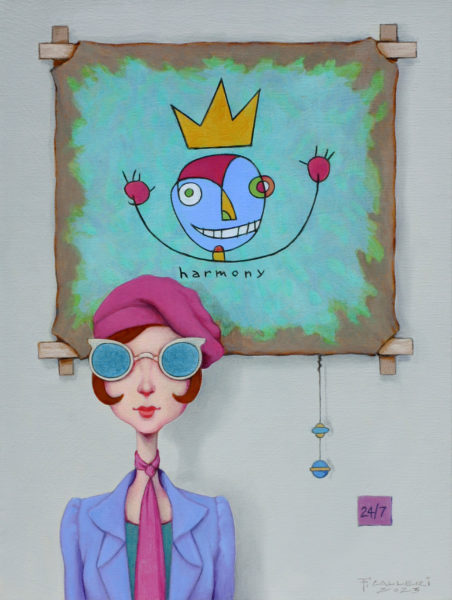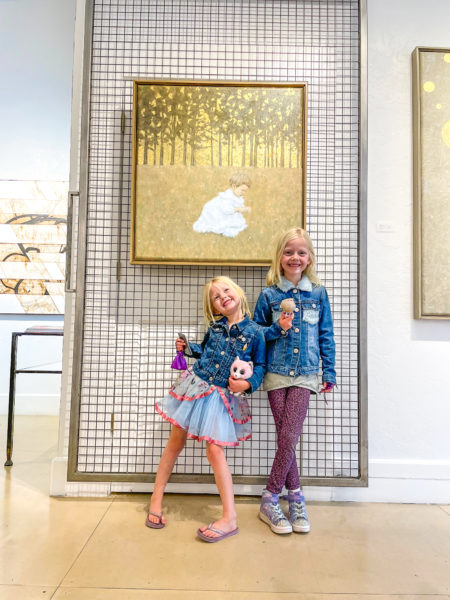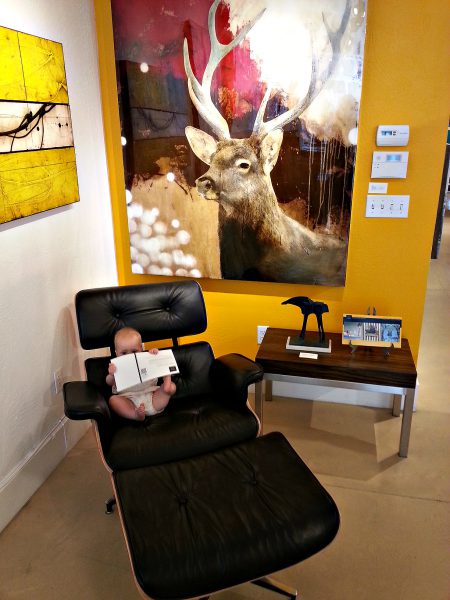May 14th, 2023
Children Who Are Exposed to Awe-Inspiring Art Are More Likely to Become Generous, Empathic Adults, a New Study Says.

“At the MOMA Harmony”, by Fred Calleri
The study found that children who viewed inspiring videos were more likely to help refugees.
Want to raise kind, generous kids? Take them to the art museum! Here in Park City, we regularly have families visit the gallery. They give us a head’s up when they open the front door and announce, “Don’t touch anything!” It makes us smile. Kids are always welcome, and they should learn to be respectful of fine art collections whether they are in a gallery, a museum or in their own home.
Kids are always welcome, and they should learn to be respectful of fine art collections whether they are in a gallery, a museum or in their own home.
The feeling of awe inspired by great artists, it turns out, can be a humbling experience that encourages kids to help others, rather than focusing on their own needs.

Faye and Jane Mullin at Gallery MAR
“In encounters with vast mysteries, awe makes individuals feel small, humble, and less entitled, thereby shifting their attention toward the needs and concerns of others rather than the self,” read a new study in Psychological Science.
Lead author Eftychia Stamkou, of the department of psychology at the University of Amsterdam, decided to investigate the effects of experiencing awe on children after realizing the feeling had been extensively studied in adults, where it led to less self-entitlement and greater generosity. Stamkou’s study, which included 159 volunteers aged 8 to 13, suggests the results are much the same for kids, reports Inc.
Participants watched short movie clips designed to elicit either joy, awe, or a neutral response—the wine-drinking scene from Fantasia, a clip from Song of the Sea in which a character turns into a seal, and an instructional video about painting walls or making coffee, respectively.
Researchers then asked the children to complete an easy but time-consuming task of counting items for a food drive for families in need, or, instead, if they would be willing to donate the art museum tickets or chocolate snacks they were supposed to receive for participating in the study to a refugee family.

Baby Jane lounges
“Children who watched the awe-inspiring video chose to count 50 percent more items for the food drive than children who watched the joy-inspiring clip and more than twice as many items as children who watched the neutral clip. Children in the awe-inspiring condition were also two to three times more likely to donate their study rewards than children in the joyful or neutral conditions,” the Association for Psychological Science blog reported.
“Awe, an aesthetic and moral emotion, helps societies flourish by making children more generous,” the study claimed. “Our research is the first to demonstrate that awe-eliciting art can spark pro-sociality in children.”
Though the researchers didn’t use famous paintings or sculptures to evoke awe in the study, they did note that their findings could help prove that art can offer benefits to society as a whole, not just to the individual.
If awe-inspiring art really does encourage people to act more selflessly, it would counter “the still-common perception that art has hardly any real-world consequences on human behavior because art experiences are bracketed in imaginary, non-real worlds,” read the study. “Our research provides concrete evidence for art’s behavioral consequences on outcomes that promote other people’s well-being.”
And an addition from Eileen Treasure, Manager:
Feed your kid’s passion for art. We all believed we were artists when we were 5, but somewhere along the road we heard negative criticism, we stopped believing and stopped creating. It’s tragic! I recall my elementary school principal visited our classroom when I was 7 or 8 and gave my drawing (really just a doodle) a positive critique. It meant the world to me and it inspired me to continue to create through the difficult years of early education onto a Bachelor’s Degree. When I taught art at a private school, one rule of the classroom I firmly enforced was that there would not be any negative criticism or ‘making fun’ of someone else’s work. None. Save that for college when you have the maturity to learn from constructive criticism. If your child learns to respect and appreciate art, they will be a more well-rounded and kind person.
We welcome families to visit Gallery MAR and engage their children in the art collection. Encourage them to continue creating. It’s well worth the investment.
 The Art of People - Capturing Sonder
The Art of People - Capturing Sonder Carving the Canvas: Ski Season Through the Eyes of Our Artists
Carving the Canvas: Ski Season Through the Eyes of Our Artists Picture This: Horsepower
Picture This: Horsepower